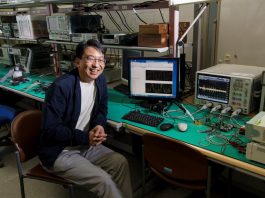Researchers at KAUST are developing a state-of-the-art approach to semiconductor solar cells using a microns-thick absorber layer consisting of perovskite single crystals.
A novel synthetic approach that improves absorber layers in perovskite solar cells could help them achieve their full potential and draw closer to the performance of leading gallium arsenide devices.
Solar cells that depend on perovskite thin films in order to capture sunlight are fast growing photovoltaic technologies. Lead halide perovskites are more cost effective and easier to manufacture than conventional semiconductors. They also efficiently absorb visible light and display long charge carrier diffusion lengths, which suggests capability to retain light-induced electrons and holes separation, and enable charge transport.
The performance of semiconductor solar cells centres around absorber materials with a high-quality crystal structure and a narrow bandgap to optimise sunlight harvesting. This maximised bandgap range spans energies of 1.1 to 1.4 eV, corresponding to near-infrared wavelengths.
Absorber layers that comprise of polycrystalline lead halide perovskites have offered highly effective solar cells. However, their application has been affected by structural disorder and defects.
Formamidinium lead triiodide contains the smallest bandgap discovered so far, but this bandgap surpasses the ideal range for single-junction devices. One way to minimise the bandgap of perovskites entails forming lead–tin alloys in the absorber, although this introduces crystal defects and instability.
A team of researchers from KAUST has now developed a method utilising a microns-thick absorber layer consisting of perovskite single crystals to decrease the bandgap. The crystals contain a combination of methylammonium and formamidinium organic cations.
The team assimilated the mixed-cation perovskite into unconventional inverted p–i–n solar cells, whereby the absorber is inserted between an electron transport top layer and a hole transport bottom layer.
The resulting solar cells demonstrated a proficiency of 22.8%, exceeding the best-performing devices using single-crystal methylammonium lead triiodide.
“We had known that mixed-cation single-crystal absorbers could outperform single-cation absorbers due to their lower bandgap and superior optoelectronic qualities. However, this had not been realised before because of challenges in crystal growth and device integration,” explained Abdullah Alsalloum, a Ph.D student in the team.
The external quantum proficiency of the mixed-cation perovskite film, which processes its efficacy when converting incoming light into charge carriers, shifted toward near-infrared wavelengths from that of polycrystalline formamidinium lead triiodide, which is consistent with its smaller bandgap.
“By utilising a thicker single-crystal absorber layer, we expanded the absorption range of the film so that it’s very close to the optimal range,” Alsalloum said.
Going forward, the researchers will be working to improve the device performance and stability to get nearer to the best-performing gallium arsenide solar cells.
“Future studies include optimising device interfaces and exploring more favourable device structures,” Alsalloum added.









